Kawasaki Launches World’s First 1.8 MW Class, 100% Hydrogen-fueled, Dry-combustion Gas Turbine Cogeneration System
Sep. 05, 2023
Kawasaki Heavy Industries, Ltd. announced its launch of sales for the GPB17MMX, a 1.8 MW class gas turbine cogeneration system equipped with the world’s first combustor capable of 100% hydrogen-fueled dry combustion. * 1
Generator sets that use hydrogen fuel, have a faster combustion speed and higher combustion temperature than natural gas, leading to technical challenges such as a significant increase of NOx*2 emissions and overheating of the burners. Kawasaki has addressed these shortcomings by successfully developing a 100% hydrogen-fueled dry combustor that utilizes a proprietary combination of micromix combustion*3 and supplemental combustion.*4 This system achieves stable hydrogen combustion to keep NOx emission levels lower than the maximum permissible values stipulated under the Air Pollution Control Act. Furthermore, the system is compatible with mixed-fuel combustion using both hydrogen and natural gas. The hydrogen volume ratio can be freely adjusted between 50 and 100%, which enables flexible operation according to hydrogen supply fluctuations.
Kawasaki’s combustor utilizes technologies developed as part of the New Energy and Industrial Technology Development Organization’s (NEDO) Technology Development Project for Building a Hydrogen Society.*5 Specifically, the technologies were developed for the FY2019–20 Technology Development and Verification Project for 100% Hydrogen-fueled Gas Turbine Operation with Dry Low-NOx Combustion Technology, and the FY2021–22 Hydrogen CGS Technology Research and Development Project for Regional Model Establishment.
Foreseeing a significant increase in the use of hydrogen energy in the future, which will play a vital role in achieving a decarbonized society, Kawasaki is developing a range of technologies for the hydrogen supply chain (production, transportation, storage, and utilization). Hydrogen gas turbines are one of the key elements in the “utilization” stage that significantly reduce carbon emissions in Japan’s power generation sector, which produces about 40% of the nation’s CO2 emissions. Kawasaki will continue to develop gas turbine combustion technologies that encourage greater utilization of hydrogen. *6

GPB17MMX Specifications
| Gas turbine model | M1A-17 | ||
|---|---|---|---|
| Power generation output (kW) | 100%vol hydrogen combustion | 1786 | |
| 50%vol hydrogen (mixed) combustion | 1744 | ||
| Hydrogen co-firing ratio (volume %) | 50~100 | ||
| Fuel consumption (Nm3) | 100%vol hydrogen combustion | Hydrogen | 2126 |
| 13A gas | 0 | ||
| 50%vol hydrogen (mixed) combustion | Hydrogen | 440 | |
| 13A gas | 440 | ||
| Steam output (t/hr.) [when steam pressure is at 0.78 MPaG] |
5.0 | ||
| NOx emissions (ppm, O2=16%) | Max. 70 ppm | ||
| Gas turbine operating load range*7 | 0-100%kW | ||
| *1 | A method of reducing NOx emission volumes by keeping combustion temperatures low without relying on water and steam injection. However, controlling combustion temperature becomes more difficult. |
| *2 | Nitrogen oxides. A category of oxides formed through the joining of nitrogen and oxygen in the air as a result of high-temperature combustion. NOx are causal factors in photochemical smog and acid rain. NOx emission amounts are limited by the Air Pollution Control Act and local government ordinances. |
| *3 | Small injection holes (measuring 1 mm or less in diameter) are used to inject fuel in small amounts, and the fuel is burned with numerous microflames, which eliminates localized high-temperature zones to ensure consistently low NOx emissions. |
| *4 | A method of combustion in which fuel is injected downstream of micromix combustion. This method can be used to change output levels while maintaining stable micromix combustion by adjusting supplemental fuel and enables NOx emissions to be kept low. |
| *5 | Project name: Technology Development Project for Building a Hydrogen Society Project period: FY2014–25 Project overview: https://www.nedo.go.jp/english/activities/activities_ZZJP_100096.html |
| *6 | Kawasaki’s hydrogen gas turbine development roadmap(P19): https://global.kawasaki.com/en/energy/pdf/20220915_hydrogen-introduction_e.pdf |
| *7 | Individual assessments are required based on steam and water-supply conditions in order to determine the boiler operating load range. |
Contact
If you need more information about our business,
please feel free to contact us.





